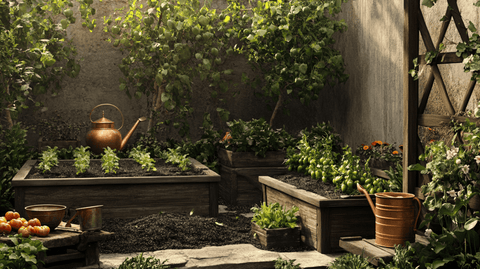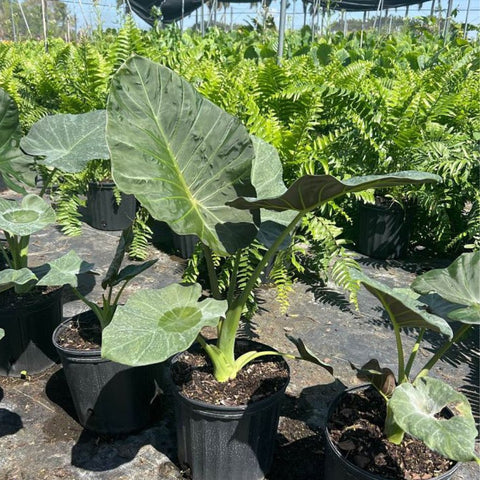Introduction
Spring is a season of renewal and growth, inviting gardeners to return to their plots and break the dormancy of winter. As the days gradually warm up, early spring provides the perfect opportunity to give your garden a head start. This period offers gardeners a chance to maximize the growing season and ensure a bountiful harvest. At Plantology, we are excited to guide you through the process of early spring planting, helping you bring life back to your garden with vibrant vegetables.

Understanding Early Spring Planting
Definition and Timing
Early spring planting refers to the practice of sowing seeds or transplanting seedlings into the garden as soon as the soil can be worked after the last frost. This usually occurs from late February to early April, depending on your region and climate. The precise timing is critical as it determines the success of your garden's growth cycle.
Key Dates and Regional Considerations
Timing varies significantly by location. For instance, gardeners in the southern US might start planting much earlier than those in the northern states. Use the USDA Hardiness Zone Map as a guideline to determine your planting schedule. Knowing your specific last frost date will ensure that you plant at the right time and gives your vegetables the best chance to thrive.
Climate Considerations
Weather patterns greatly influence early planting. Pay attention to last frost dates, soil temperature, and unexpected cold snaps. Use row covers or cloches to protect tender plants from sudden temperature drops. Timing your planting to align with climate conditions is pivotal in achieving a successful early spring garden.
Choosing the Right Vegetables for Early Spring
Hardy Varieties
Certain vegetables thrive in cooler temperatures and can be planted in early spring. These hardy varieties are frost-tolerant and can survive the chilly nights. Examples include:

- Peas: Sow peas directly into the soil as soon as it is workable. They thrive in cooler weather.
- Kale: Known for its hardiness, kale can even survive under a light layer of snow.
- Spinach: Enjoys the cool, moist conditions of early spring, quickly producing lush, edible leaves.
Quick-Growing Varieties
Some vegetables can be planted early because they grow fast and mature before the heat of summer sets in. Consider planting:
- Radishes: Extremely quick to mature, often ready to harvest in just 30 days.
- Leaf Lettuce: Fast-growing and can be harvested repeatedly for fresh salads throughout spring.
- Arugula: Another leafy green that grows rapidly, ideal for a quick-greens fix.
Preparing Your Garden for Early Planting
Soil Preparation
Start by clearing your garden bed of any debris and weeds leftover from the winter. Loosen the soil with a garden fork or tiller, and add organic matter such as compost to enhance fertility. Proper soil preparation facilitates root growth and nutrient absorption, setting a strong foundation for your vegetables.
Creating Ideal Growing Conditions
For optimal early spring planting, consider using raised beds or containers, which warm quicker than ground soil. Implement protective measures like mulch to retain moisture and moderate soil temperature. Additionally, consider companion planting arrangements that naturally repel pests and improve plant health.

Sowing Seeds and Transplanting Seedlings
Direct Sowing Techniques
Direct sowing is the traditional method of planting seeds directly into the garden soil. Follow spacing and depth recommendations on seed packets for optimal germination. Water gently after planting, ensuring seeds remain moist but not waterlogged.
Transplanting Seedlings
For certain vegetables, starting seeds indoors and transplanting seedlings outdoors is advantageous. Harden off seedlings by gradually exposing them to outdoor conditions over a week. When transplanting, plant at the same depth as they were growing in containers to prevent shock and promote healthy adaptation.
Maintaining Your Early Spring Garden
Watering Needs
As temperatures rise, consistent watering is crucial for young plants. Early spring usually provides ample rain, but do not rely solely on rainfall. Water early in the morning to reduce evaporation and encourage deep root growth.
Fertilization Tips
Apply a balanced organic fertilizer to provide essential nutrients. As plants establish, switch to specific fertilizers that cater to the nutrient needs of each vegetable variety. Regular feeding helps maintain vigor and increases yield.

Pest and Disease Management
Common Early Spring Pests
Watch out for pests such as aphids, slugs, and flea beetles, which are early spring nuisances. Use natural pest deterrents like neem oil or diatomaceous earth to protect your crops.
Disease Prevention
Prevent disease by ensuring good air circulation and preventing standing water. Practice crop rotation and utilize resistant varieties to minimize disease risks.
Harvesting Early Spring Vegetables
Signs of Maturity
Each vegetable variety has distinct signs of readiness for harvest. Familiarize yourself with these signals to ensure you pick your produce at peak flavor and nutritional value.
Harvesting Techniques
Use clean, sharp tools for harvesting to avoid damaging the plants. Regular picking can also encourage further production, especially in leafy greens and herbs.
Storing and Using Spring Harvest
Proper Storage Solutions
Preserve your harvest through proper storage methods. Leafy greens and peas can be refrigerated, while root vegetables like radishes benefit from cellar storage.

Creative Culinary Uses
Early spring produce offers endless culinary possibilities. Use fresh greens in salads, make hearty soups with kale and spinach, or pickle excess radishes for a tangy treat.
Plantology's Recommendations: Early Spring Favorites
Looking to gear up your garden with the best early spring vegetables? At Plantology, our extensive selection of plants and trees will cater to your every gardening need. Explore our offerings by visiting Plantology for top-quality seeds and plants perfect for early spring planting.
Featured Product: Agapanthus 'Lily of The Nile'
Bring vibrant color to your early spring garden with our featured Agapanthus 'Lily of the Nile'. Its stunning blue blooms will make your garden a sure standout this spring.
Planning Ahead: What Comes After Early Spring
Transitioning to Late Spring Crops
As temperatures stabilize, prepare to plant additional varieties suited for warmer weather. Begin sowing beans, squash, and cucumbers directly into the garden.
A Year-Round Gardening Strategy
Implement continuous planting strategies, sowing seeds every few weeks to ensure a consistent supply of fresh vegetables. Companion planting and crop rotation help maintain soil fertility and health for the entire growing season.

The Promise of a Bountiful Harvest
With careful planning and preparation, early spring planting opens the door to a season of abundance. By choosing the right varieties and tending to your garden's unique needs, you can enjoy fresh, home-grown vegetables well into summer. So why wait? Bring new life to your garden by visiting Plantology today, and let us supply you with everything you need for a thriving vegetable garden. Happy spring planting from the Plantology team!
Enhancing Early Spring Gardening Techniques
Utilizing Season Extension Materials
As experienced gardeners know, maximizing the growing season is crucial for a high yield. One effective way to achieve this is by utilizing season extension materials such as hoops, row covers, and greenhouse films. These tools can protect your crops from unexpected frost and keep soil temperatures stable, allowing you to start planting even earlier in the season.
Hoop houses, or low tunnels, are simple structures made using PVC or flexible metal wires to form a structure over which a transparent plastic cover is draped. This setup creates a mini-greenhouse effect, trapping heat and moisture, thus providing a more favorable microclimate for plant growth. They are particularly beneficial for protecting early seedlings during cold snaps.
Cold Frame Construction
Another technique that serves well for early spring gardening is the construction of cold frames. These are essentially box structures with a transparent lid, crafted to capitalize on solar energy to warm the soil and the plants inside. Cold frames can be crafted from repurposed materials like old windows or clear plastic panels, making them an eco-friendly and cost-effective addition to your garden.

Cold frames are particularly beneficial when hardening off seedlings. By gradually opening the lid, seedlings become accustomed to outdoor temperatures, which minimizes transplant shock when they are finally placed in their permanent garden spot.
Optimizing Soil Health for Spring Planting
Understanding Soil Composition
The health of your garden begins with its soil. Understanding soil composition is essential to creating an environment that supports robust plant growth. Soil contains three primary particles: sand, silt, and clay. A balanced combination of these particles creates loamy soil, which is ideal for garden growth due to its excellent drainage and nutrient-retention capabilities.
Testing and Amending Soil
Before planting, it's advantageous to test your soil for pH levels and organic content. Home test kits are available, or samples can be sent to local cooperative extensions for detailed analysis. Based on these results, amendments like lime, sulfur, compost, and organic fertilizers can be added to adjust pH levels and improve soil fertility.
Ensuring consistent soil health involves incorporating organic matter—such as well-rotted manure, leaf mold, or other composted materials—into your garden beds. This practice not only enhances soil structure but also supports a thriving ecosystem of beneficial microorganisms crucial for plant growth.
Environmental and Sustainable Practices in Early Spring Gardening
Water Conservation Techniques
Water is a precious resource that requires mindful usage, especially in gardening. Employing water-conserving techniques not only reduces water waste but also contributes to healthier plant growth. Techniques such as drip irrigation systems deliver water directly to the soil, minimizing evaporation and ensuring deep watering.

Mulching is another highly effective strategy. Apply a layer of organic mulch, such as straw or wood chips, around your plants to help retain soil moisture, suppress weeds, and protect plant roots from temperature fluctuations.
Rainwater Harvesting
Collecting rainwater is a sustainable practice that reduces reliance on municipal water supplies. Set up barrels or tanks connected to gutter systems to capture rain. This water can then be used for irrigation during dry spells, providing a reliable, natural water source for your garden.
Zero-Waste Garden Practices
In keeping with a zero-waste lifestyle, consider composting your kitchen scraps and garden waste. Composting provides rich organic material for your garden, completing a cycle where nothing is wasted, and fertility is cycled back into the soil. Crop residues, fallen leaves, and even shredded paper can contribute to a productive compost system.
Companion Planting for Early Spring Vegetables
Understanding Companion Planting
Companion planting involves strategic placement of different crops in close proximity to each other to capitalize on mutually beneficial interactions. This practice serves several purposes, including pest control, pollination enhancement, and resource sharing, ultimately leading to higher yields.
Beneficial Plant Pairings
When planning your early spring garden, consider incorporating companion pairings to improve outcomes:

- Peas and Carrots: Peas can help fix nitrogen in the soil, providing essential nutrients for carrots planted nearby.
- Kale and Beets: Kale acts as a ground cover, protecting beets from sun exposure and reducing rot risks.
- Spinach and Radishes: Radishes can deter pests that would typically target spinach, offering a natural defense.
Creating a Biodiverse Garden
Incorporate a mix of flowering plants and herbs like marigolds, basil, and dill to attract pollinators and beneficial insects. This biodiversity helps keep pest populations in check, reducing the need for chemical interventions and supporting a more resilient garden ecosystem.
Advanced Tips for Early Spring Gardening Success
Implementing Crop Rotation
Crop rotation is a traditional practice that helps maintain soil health and reduce pest and disease build-up. By rotating families of vegetables each season, you avoid soil nutrient depletion and minimize fungal disease and pest reinfestation.
For example, follow a leafy green like spinach with legumes such as peas, which improve soil nitrogen levels. The season after legumes can be dedicated to vegetables like carrots or beets that require less nitrogen. Planning a crop rotation schedule ensures your garden remains productive over the long term.

Using Organic Pest Control Methods
Promote a healthy garden by employing organic pest management strategies that minimize harm to your crops and the environment. Introducing beneficial insects like ladybugs and lacewings, which prey on common pests such as aphids, can be highly effective.
Homemade insecticidal soaps and organic sprays, made from ingredients like garlic and neem oil, offer further defense against harmful pests. Remember, a diverse and balanced garden is less susceptible to pest outbreaks.
Engaging with Community Gardening Networks
Engage with online gardening forums, local gardening clubs, and community gardens to expand your knowledge and skills. Sharing experiences and tips with fellow gardeners can provide new insights and solutions to common challenges faced during early spring planting.
Participating in such networks also promotes a sense of community and shared responsibility for creating sustainable and fruitful gardening practices.
Final Thoughts on Early Spring Gardening
Embarking on early spring gardening is not only a fulfilling activity but also an opportunity to cultivate a stronger connection with nature. This season holds the promise of growth and renewal, making it the ideal time to try new plants and techniques that complement your gardening experience.

As you prepare your garden to flourish in the months ahead, embrace the potential for experimentation. Explore seed varieties, new planting arrangements, and sustainable practices that can enrich both your garden’s bounty and the environment. Every step you take contributes to a larger, more sustainable gardening philosophy, with the bonus of freshly harvested, flavorful produce to enjoy and share.
Remember that every garden is a learning landscape. Eager to impart our knowledge and enthusiasm, Plantology encourages you to embrace the art and joy of gardening. With dedication and passion, your early spring efforts will surely yield a vibrant, generous harvest.
Go forth and cultivate—equip yourself with first-class seeds and support from Plantology. Visit our online store today and let us be part of your gardening journey. Happy planting!






























Comments (0)
There are no comments for this article. Be the first one to leave a message!